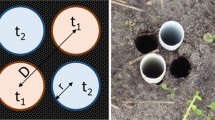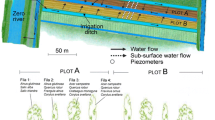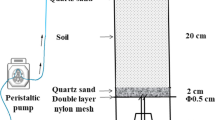Abstract
The authors submit the results of study of nitrification in soil samples, using the continuous flow method. The course of nitrification was studied in soil samples continuously enriched with differently concentrated ammonium sulphate solutions and in soil samples of different weights (i.e. soil columns of different heights). The ammonium ions were oxidized after a short lag phase, the length of which depended on the ammonium nitrogen concentration. An exponential phase of nitrite formation was then observed. A steady state in the oxidation of ammonium ions was observed only with a continuous flow of low ammonium sulphate concentrations. After a given time, which was in inverse proportion to the ammonium sulphate concentration, the rate of nitrite and nitrate formation decreased. It was found that the factor limiting the rate of oxidation of ammonium ions was the degree of their adsorption in the soil. It was confirmed that ammonium ions were oxidized in the soil in the adsorbed state. It was also found that the oxidation of synthesized nitrite to nitrate was influenced by the concentration of continuously added ammonium ions and that the rate of oxidation increased with the height of the soil column. The results showed that the bacteria oxidizing ammonium ions to nitrite and nitrite to nitrate were localized in different parts of the soil column.
Abstract
Приводятся результаты изучения нитрификации образцов почвы с применением непрерывного проточного метода. Исследовался процесс нитрификации в образцах иочвы, непрерывно обогащавшихся раствором сернокислого аммония различной концентрации, а также в образцах почвы различного веса, т. е. и различной высоты столбца. Окисление ионов аммония начиналось после короткой фазы задержки роста, продолжительность которой зависела от концентрации сернокислого аммония. После фазы задержки роста наблюдалась экспоненциальная фаза образования нитритов. Что касается окисления ионов аммония, постоянное соотношение наблюдалось только при непрерывном протоке низких концентрации сернокислого аммония. Через определенное время, которое было тем короче, чем выше была концентрация сернокислого аммония, наблюдалось уменьшение скорости образования нитритов и нитратов. Оказалось, что фактором, лимитирующим скорость окисления ионов аммония, была интенсивность их адсорбции в почве. Подтвердилось, что ионы аммония в почве окисляются в адсорбированном состоянии. Далее, было установлено, что окисление образующегося нитрита и его превращение в нитрат зависит от концентрации непрерывно подводимых ионов аммония и что оно протекает тем быстрее, чем выше столбец почвы. Результаты опытов показали, что бактерии, окисляющие ионы аммония в нитриты, и бактерии, превращающие нитриты в нитраты, локализуются в различных слоях столбца почвы.
Similar content being viewed by others
References
Engel, M. S., Alexander, A.:Culture of Nitrosomonas europaea in media free of insoluble constituents. Nature 181: 136, 1958.
Lees, H.:The soil percolation technique. Plant & Soil 1: 221, 1949.
Lees, H., Quastel, J. H.:Biochemistry of nitrification in soil. I. Kinetics of and the effects of poisons on, soil nitrification as studied by soil perfusion technique. Biochem. J. 40: 803, 1946.
Lees, H., Quastel, J. H.:Biochemistry of nitrification in soil. II. The site of soil nitrification. Biochem. J. 40: 815, 1946b.
Macura, J.:Continuous flow method in soil microbiology. I. Apparatus. Fol. microbiol. 6: 328, 1961.
Macura, J.The use of continuous flow method in soil microbiology. In: I. Málek, Continuous Cultivation of microorganisms (in Czech), p. 399. Publ. House Cz. Acad. Sci., Prague 1964.
Macura, J., Kunc, F.:Continuous flow method in soil microbiology. II. Observations on glucose metabolism. Fol. microbiol. 6: 398, 1961.
Macura, J., Kunc, F.:Continuous flow method in soil microbiology. III. Biological immobilization of nitrogen and phosphorus. Fol. microbiol. 10, 36, 1965a.
Macura, J., Kunc, F.:Continuous flow method in soil microbiology. IV. Decomposition of glycine. Fol. microbiol. 10: 115, 1965b.
Macura, J., Málek, I.:Continuous flow method for the study of microbiological processes in soil samples. Nature 182: 1796, 1958.
Quastel, J. H.:Microbial activities of soil as they affect plant nutrition. In “Plant Physiology” (Ed. F. C. Steward), p. 671, Academic Press, New York and London 1963.
Quastel, J. H., Scholefield, P. G.:Biochemistry of soil nitrification. Bact. Rev. 15: 1, 1951.
Seifert, J.:Influence of the size of soil structural aggregates on the degree of nitrification. Fol. microbiol. 9: 115, 1964.
Skinner, F. A., Walker, N.:Growth of Nitrosomonas. europaea in batch and continuous culture. Arch. Mikrobiol. 38: 339, 1961.
Stojanovic, J., Alexander, M.:Effect of inorganic nitrogen on nitrification. Soil Sci. 86: 208, 1958.
Author information
Authors and Affiliations
Rights and permissions
About this article
Cite this article
Macura, J., Kunc, F. Continuous flow method in soil microbiology. Folia Microbiol 10, 125–135 (1965). https://doi.org/10.1007/BF02888914
Received:
Issue Date:
DOI: https://doi.org/10.1007/BF02888914




